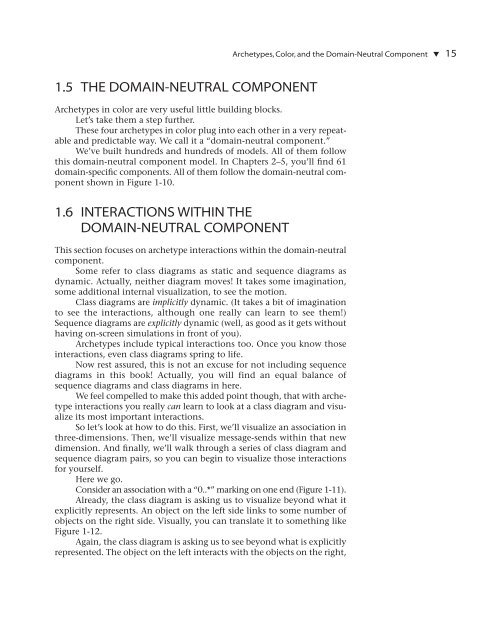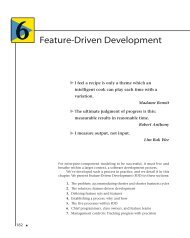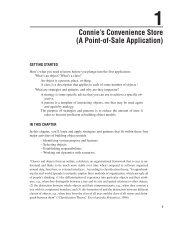Archetypes, Color, and the Domain-Neutral ... - Petercoad.com
Archetypes, Color, and the Domain-Neutral ... - Petercoad.com
Archetypes, Color, and the Domain-Neutral ... - Petercoad.com
You also want an ePaper? Increase the reach of your titles
YUMPU automatically turns print PDFs into web optimized ePapers that Google loves.
<strong>Archetypes</strong>, <strong>Color</strong>, <strong>and</strong> <strong>the</strong> <strong>Domain</strong>-<strong>Neutral</strong> Component ▼ 151.5 THE DOMAIN-NEUTRAL COMPONENT<strong>Archetypes</strong> in color are very useful little building blocks.Let’s take <strong>the</strong>m a step fur<strong>the</strong>r.These four archetypes in color plug into each o<strong>the</strong>r in a very repeatable<strong>and</strong> predictable way. We call it a “domain-neutral <strong>com</strong>ponent.”We’ve built hundreds <strong>and</strong> hundreds of models. All of <strong>the</strong>m followthis domain-neutral <strong>com</strong>ponent model. In Chapters 2–5, you’ll find 61domain-specific <strong>com</strong>ponents. All of <strong>the</strong>m follow <strong>the</strong> domain-neutral <strong>com</strong>ponentshown in Figure 1-10.1.6 INTERACTIONS WITHIN THEDOMAIN-NEUTRAL COMPONENTThis section focuses on archetype interactions within <strong>the</strong> domain-neutral<strong>com</strong>ponent.Some refer to class diagrams as static <strong>and</strong> sequence diagrams asdynamic. Actually, nei<strong>the</strong>r diagram moves! It takes some imagination,some additional internal visualization, to see <strong>the</strong> motion.Class diagrams are implicitly dynamic. (It takes a bit of imaginationto see <strong>the</strong> interactions, although one really can learn to see <strong>the</strong>m!)Sequence diagrams are explicitly dynamic (well, as good as it gets withouthaving on-screen simulations in front of you).<strong>Archetypes</strong> include typical interactions too. Once you know thoseinteractions, even class diagrams spring to life.Now rest assured, this is not an excuse for not including sequencediagrams in this book! Actually, you will find an equal balance ofsequence diagrams <strong>and</strong> class diagrams in here.We feel <strong>com</strong>pelled to make this added point though, that with archetypeinteractions you really can learn to look at a class diagram <strong>and</strong> visualizeits most important interactions.So let’s look at how to do this. First, we’ll visualize an association inthree-dimensions. Then, we’ll visualize message-sends within that newdimension. And finally, we’ll walk through a series of class diagram <strong>and</strong>sequence diagram pairs, so you can begin to visualize those interactionsfor yourself.Here we go.Consider an association with a “0..*” marking on one end (Figure 1-11).Already, <strong>the</strong> class diagram is asking us to visualize beyond what itexplicitly represents. An object on <strong>the</strong> left side links to some number ofobjects on <strong>the</strong> right side. Visually, you can translate it to something likeFigure 1-12.Again, <strong>the</strong> class diagram is asking us to see beyond what is explicitlyrepresented. The object on <strong>the</strong> left interacts with <strong>the</strong> objects on <strong>the</strong> right,




